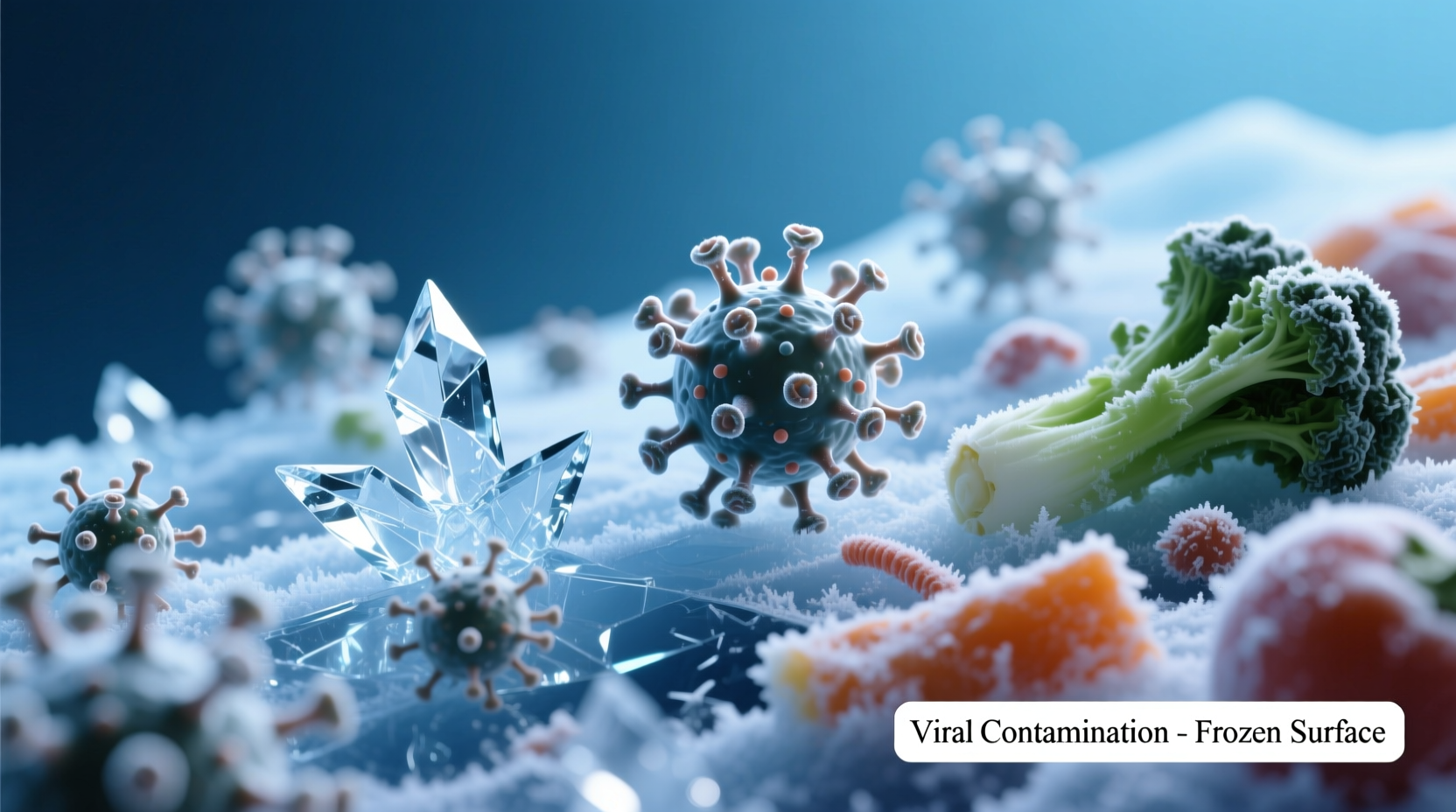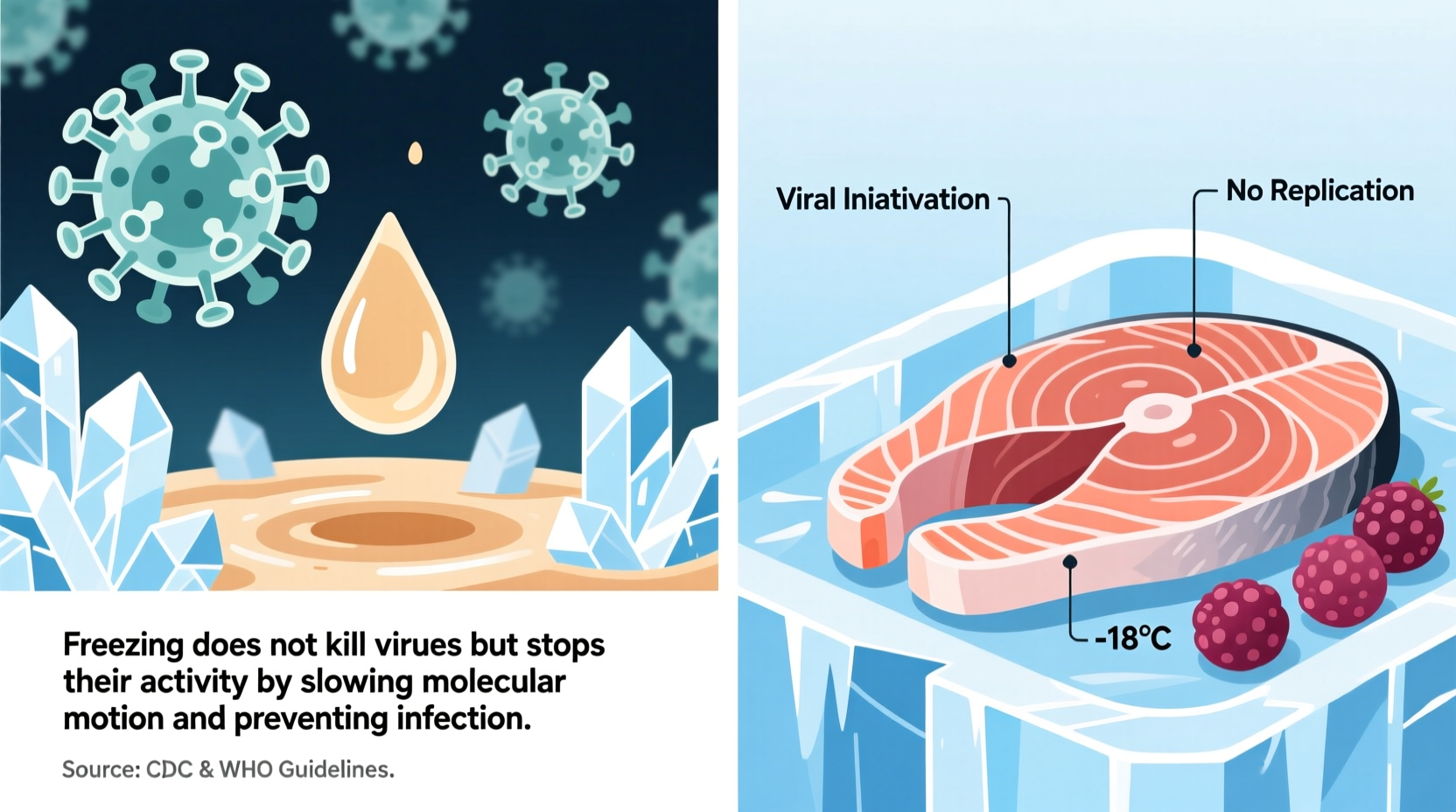Freezing food preserves viruses rather than killing them. Most foodborne viruses like norovirus and hepatitis A remain dormant but viable in frozen conditions for months or even years. Proper cooking, not freezing, is required to destroy viral pathogens in food.
Understanding Viral Survival in Frozen Food: Science-Backed Facts
When you place food in the freezer, you're creating an environment where viruses enter suspended animation—not death. This critical distinction affects how we handle frozen foods safely. Let's explore exactly what happens to viruses when food is frozen and what it means for your kitchen practices.
Why Freezing Preserves Viruses Instead of Destroying Them
Unlike bacteria, which can reproduce in favorable conditions, viruses require living host cells to replicate. When food containing viruses is frozen:
- Water molecules form ice crystals, dramatically slowing all biological activity
- Viral particles become encased in ice, entering a dormant but intact state
- Metabolic processes stop completely at typical freezer temperatures (-18°C/0°F)
- The virus's genetic material remains protected within its protein shell
This preservation effect explains why virologists routinely store viral samples at ultra-low temperatures for research. The same principle applies to viruses contaminating your food.

How Long Viruses Survive in Frozen Conditions
Research shows remarkable viral longevity in frozen environments. The duration varies significantly by virus type and food matrix:
| Virus Type | Survival in Frozen Food | Documented Cases |
|---|---|---|
| Norovirus | 6-12+ months | Oysters frozen for 5 months transmitted illness (CDC, 2021) |
| Hepatitis A | 12-24+ months | Frozen berries caused outbreaks after 18 months storage (WHO, 2022) |
| Rotavirus | 3-6 months | Detected in frozen ready-to-eat meals (FDA Study, 2023) |
| SARS-CoV-2 | 2-3 weeks | Less stable in frozen food than other enteric viruses (NIH, 2022) |
The Freezing Process Timeline: What Happens to Viruses Minute-by-Minute
Understanding the progression of viral inactivation (or preservation) during freezing helps clarify why temperature matters:
- 0-30 minutes: As food cools from refrigeration to freezing temperatures, viral activity slows but remains possible
- 30-120 minutes: Ice crystals begin forming, physically trapping viruses in protective pockets
- 2-24 hours: Complete freezing occurs; viruses enter fully dormant state with intact genetic material
- Days to years: Viruses remain viable but inactive as long as temperature remains consistently below -18°C (0°F)
- Thawing phase: Upon warming, viruses regain ability to infect if they contact susceptible tissue
Practical Food Safety Implications You Need to Know
These scientific realities translate to specific kitchen practices that actually protect your health:
What Freezing Does NOT Accomplish
Many home cooks mistakenly believe freezing eliminates viral risks. Research confirms freezing does not:
- Destroy viral capsids (protein shells protecting genetic material)
- Inactivate viruses sufficiently to prevent transmission
- Replace the need for proper cooking temperatures
- Make contaminated food safe to eat raw after thawing
When Freezing Provides Limited Protection
While freezing preserves viruses, it does prevent bacterial growth that might otherwise mask viral contamination. This creates important context boundaries:
- Freezing stops bacterial spoilage that would normally make contaminated food unpalatable
- Viruses in frozen food lack the "warning signs" of bacterial spoilage (odors, slime)
- This makes viral contamination in frozen products particularly insidious
- Never assume frozen food is safe to eat without proper cooking
Proven Methods to Actually Eliminate Viral Risks in Food
Since freezing preserves rather than destroys viruses, you need reliable methods to ensure food safety:
Effective Viral Inactivation Techniques
- Cooking to proper temperatures: Heat food to at least 74°C (165°F) for 15 seconds to destroy most foodborne viruses (FDA Food Code)
- Adequate hand hygiene: Wash hands with soap for 20 seconds before handling food, especially after bathroom use
- Cross-contamination prevention: Use separate cutting boards for produce and proteins; sanitize surfaces after contact with raw foods
- Safe thawing practices: Thaw frozen food in refrigerator, cold water, or microwave—not at room temperature
Special Considerations for High-Risk Foods
Certain foods present greater viral risks even when frozen:
- Frozen berries: Linked to multiple hepatitis A outbreaks; always cook before consumption
- Frozen oysters and shellfish: Filter feeders concentrate viruses; require thorough cooking
- Ready-to-eat frozen meals: Verify internal temperature reaches 74°C (165°F) when reheating
- Frozen produce for smoothies: Cooking isn't practical; choose pasteurized options when available
Addressing Common Misconceptions About Frozen Food Safety
Food safety myths persist despite scientific evidence. Let's clarify the facts:
- Myth: "If it's frozen, it's safe from all pathogens" Fact: Freezing preserves viruses; bacteria like Listeria can even grow at freezer temperatures
- Myth: "Freezing kills 99% of harmful organisms" Fact: Freezing maintains viral viability; no significant reduction occurs during standard freezing
- Myth: "Longer freezing makes food safer" Fact: Viruses remain viable for years; extended freezing doesn't increase safety
- Myth: "Commercial freezing is different than home freezing" Fact: Both methods preserve viruses; commercial freezers work faster but don't destroy pathogens
Real-World Evidence: Documented Cases of Viral Transmission from Frozen Foods
Public health records confirm viral survival in frozen products:
- A 2022 European outbreak affected 300+ people from hepatitis A contaminated frozen strawberries stored for 18 months (WHO Report)
- CDC documented norovirus transmission from frozen oysters held at -20°C for 5 months
- Multiple studies show hepatitis E virus remains infectious in frozen pork products for 12+ months
- Research published in Food Microbiology (2023) confirmed SARS-CoV-2 viability in frozen conditions for 21 days
These cases demonstrate why food safety authorities emphasize that freezing is preservation—not sterilization.
Practical Steps for Safe Frozen Food Handling
Implement these evidence-based practices immediately:
- Always cook frozen meats, seafood, and poultry to proper internal temperatures
- Treat frozen berries as potentially contaminated; cook before eating
- Wash hands thoroughly after handling frozen food packaging
- Sanitize countertops and utensils that contact thawing frozen foods
- Follow manufacturer's cooking instructions for frozen meals precisely
- Never refreeze previously thawed food that reached room temperature
Remember: The only reliable method to destroy viruses in food is proper cooking. Freezing merely pauses their activity until conditions become favorable again.











 浙公网安备
33010002000092号
浙公网安备
33010002000092号 浙B2-20120091-4
浙B2-20120091-4